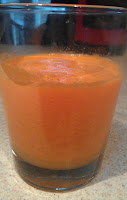Crazy, that's what. But, that's what happened to me last week.
On Monday, I got into a convo with a friend about the difference between cropped pants, ankle pants, and capri pants, and what Stacy and Clinton would say about whether we should be wearing them considering our respective body types. This is what women talk about. The next day, she sent me a picture of herself in her ankle pants and we agreed she should not wear them. The day after that, I found a pair of pants in my closet that were somewhere between cropped and capri, and which also happened to be some goal pants from about five years ago, back when I started eating clean. So I put them on and to my shock and awe, they fit! Woot! Happy dance for me.
So after I texted her a picture of myself wearing the pants (we never did decide whether they were capri or cropped, but I should not wear them either), I spent the day being quite satisfied with myself that I could get these jeans on and zip them up, even though I had the impression of the seam on my leg for about an hour after I mercifully took them off at the end of the day. Whew!
On Thursday I wore stretchy pants because a girl's gotta breathe once in a while.
On Friday, I went out for my 9 mile run, and around mile 4 I caught myself thinking, "ugh, I have really gotten fat."
Hold on a minute. What?!?
Luckily, I caught this temporary moment of insanity before it turned into full-blown fat talk, because that is just bananas. So like the good wellness coach that I am, I asked myself what was making me feel fat.
And after a little soul-searching, I realized that I feel "fat" because my stomach isn't in the best shape it could be. Whew that was close! Here I was being all mean to myself when actually, I'm just a little soft in the middle. But the rest of my life is so hard!
And after a little soul-searching, I realized that I feel "fat" because my stomach isn't in the best shape it could be. Whew that was close! Here I was being all mean to myself when actually, I'm just a little soft in the middle. But the rest of my life is so hard!
"Feeling fat," usually isn't about being fat. Research shows that "fat" is a word commonly used to describe any feeling of unhappiness that can't be named. When we're off, we're "fat."
Often, we don't even see ourselves accurately. This video from the Dove Real Beauty campaign shows just how different our own perceptions of ourselves can be from how others see us.
Like capri pants.
If you're fat talking, here's how you can stop:
1. Become aware of your fat talk, and if you don't think you can, then ask a kind and trusted friend to make you aware of it. When you catch yourself, acknowledge it and apologize to yourself.
2. Become aware of the physical things your body can do, and the physical aspects of your body that you like. Make a list and post it in a prominent place so you see it frequently.
3. For every negative thing you say to yourself, list three positive. They don't have to be about your physical self. You have a brain, too!
Get out there and get healthy....even if you felt fat yesterday.



